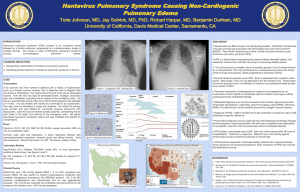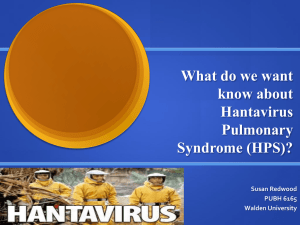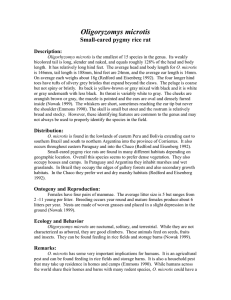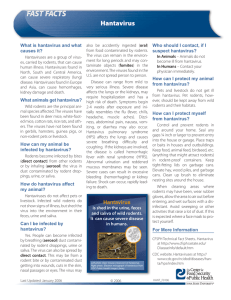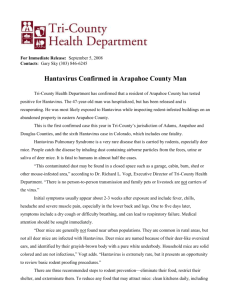Document 13607971
advertisement
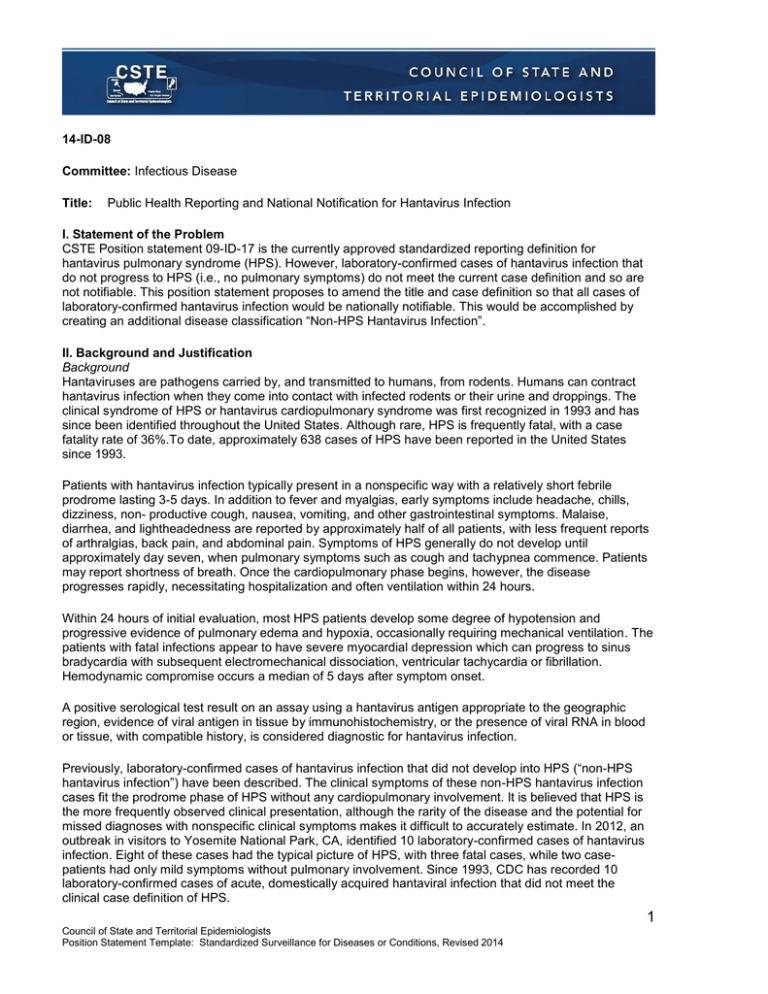
14-ID-08 Committee: Infectious Disease Title: Public Health Reporting and National Notification for Hantavirus Infection I. Statement of the Problem CSTE Position statement 09-ID-17 is the currently approved standardized reporting definition for hantavirus pulmonary syndrome (HPS). However, laboratory-confirmed cases of hantavirus infection that do not progress to HPS (i.e., no pulmonary symptoms) do not meet the current case definition and so are not notifiable. This position statement proposes to amend the title and case definition so that all cases of laboratory-confirmed hantavirus infection would be nationally notifiable. This would be accomplished by creating an additional disease classification “Non-HPS Hantavirus Infection”. II. Background and Justification Background Hantaviruses are pathogens carried by, and transmitted to humans, from rodents. Humans can contract hantavirus infection when they come into contact with infected rodents or their urine and droppings. The clinical syndrome of HPS or hantavirus cardiopulmonary syndrome was first recognized in 1993 and has since been identified throughout the United States. Although rare, HPS is frequently fatal, with a case fatality rate of 36%.To date, approximately 638 cases of HPS have been reported in the United States since 1993. Patients with hantavirus infection typically present in a nonspecific way with a relatively short febrile prodrome lasting 3-5 days. In addition to fever and myalgias, early symptoms include headache, chills, dizziness, non- productive cough, nausea, vomiting, and other gastrointestinal symptoms. Malaise, diarrhea, and lightheadedness are reported by approximately half of all patients, with less frequent reports of arthralgias, back pain, and abdominal pain. Symptoms of HPS generally do not develop until approximately day seven, when pulmonary symptoms such as cough and tachypnea commence. Patients may report shortness of breath. Once the cardiopulmonary phase begins, however, the disease progresses rapidly, necessitating hospitalization and often ventilation within 24 hours. Within 24 hours of initial evaluation, most HPS patients develop some degree of hypotension and progressive evidence of pulmonary edema and hypoxia, occasionally requiring mechanical ventilation. The patients with fatal infections appear to have severe myocardial depression which can progress to sinus bradycardia with subsequent electromechanical dissociation, ventricular tachycardia or fibrillation. Hemodynamic compromise occurs a median of 5 days after symptom onset. A positive serological test result on an assay using a hantavirus antigen appropriate to the geographic region, evidence of viral antigen in tissue by immunohistochemistry, or the presence of viral RNA in blood or tissue, with compatible history, is considered diagnostic for hantavirus infection. Previously, laboratory-confirmed cases of hantavirus infection that did not develop into HPS (“non-HPS hantavirus infection”) have been described. The clinical symptoms of these non-HPS hantavirus infection cases fit the prodrome phase of HPS without any cardiopulmonary involvement. It is believed that HPS is the more frequently observed clinical presentation, although the rarity of the disease and the potential for missed diagnoses with nonspecific clinical symptoms makes it difficult to accurately estimate. In 2012, an outbreak in visitors to Yosemite National Park, CA, identified 10 laboratory-confirmed cases of hantavirus infection. Eight of these cases had the typical picture of HPS, with three fatal cases, while two casepatients had only mild symptoms without pulmonary involvement. Since 1993, CDC has recorded 10 laboratory-confirmed cases of acute, domestically acquired hantaviral infection that did not meet the clinical case definition of HPS. 1 Council of State and Territorial Epidemiologists Position Statement Template: Standardized Surveillance for Diseases or Conditions, Revised 2014 Because hantavirus infection is acquired through exposure to rodents or their excreta, many health jurisdictions perform environmental investigations following the confirmation of a HPS case to determine the source of infection and recommend preventive measures to protect others, as appropriate. Such investigations are appropriate to carry out regardless of whether a person developed non-HPS hantavirus infection, or HPS, as the exposure leading to the infection is the same. Similarly, health jurisdictions should be aware of all hantavirus activity in their area as it relates to community education and other prevention activities. Justification As long as symptoms consistent with HPS are a required element for reporting, milder cases of hantaviral infection will continue to go uncounted. This presents a missed opportunity in understanding the full spectrum of hantaviral disease, lost opportunities to reduce exposure to prevent additional cases, and reduced awareness of where and how persons are exposed to hantaviruses. In this light, we propose that the clinical case definition should be adjusted so that all laboratory-confirmed hantaviral infections are reportable to health authorities. Hantavirus pulmonary syndrome meets the following criteria for a nationally and standard notifiable condition, as specified in CSTE position statement 08-EC-02: ● A majority of state and territorial jurisdictions—or jurisdictions comprising a majority of the US population—have laws or regulations requiring standard reporting of hantavirus pulmonary syndrome to public health authorities ● CDC requests standard notification of hantavirus pulmonary syndrome to federal authorities ● CDC has condition-specific policies and practices concerning the agency’s response to, and use of, notifications. III. Statement of the desired action(s) to be taken 1. Utilize standard sources (e.g. reporting*) for case ascertainment for hantavirus infection. Surveillance for hantavirus infection should use the following recommended sources of data to the extent of coverage presented in Table III. Table III. Recommended sources of data and extent of coverage for ascertainment of cases of Hantavirus Infection Coverage Source of data for case ascertainment Population-wide Sentinel sites Clinician reporting x Laboratory reporting x Reporting by other entities (e.g., hospitals, veterinarians, x pharmacies, poison centers) Death certificates x Hospital discharge or outpatient records x Extracts from electronic medical records x Telephone survey School-based survey Other _________________________ 2 Council of State and Territorial Epidemiologists Position Statement Template: Standardized Surveillance for Diseases or Conditions, Revised 2014 2. Utilize standardized criteria for case identification and classification (Sections VI and VII) for HPS and add non-HPS hantavirus infection to the Nationally Notifiable Condition List. 2a. Immediately notifiable, extremely urgent (within 4 hours) 2b. Immediately Notifiable, urgent (within 24 hours) 2c. Routinely notifiable CSTE recommends that all States and Territories enact laws (statute or rule/regulation as appropriate) to make this disease or condition reportable in their jurisdiction. Jurisdictions (e.g. States and Territories) conducting surveillance (according to these methods) should submit case notifications** to CDC. 3. CDC should publish data on hantavirus pulmonary syndrome and non-HPS hantavirus infection as appropriate in MMWR and other venues (see Section IX). CSTE recommends that all jurisdictions (e.g. States or Territories) with legal authority to conduct public health surveillance follow the recommended methods as outlined above. Terminology: * Reporting: process of a healthcare provider or other entity submitting a report (case information) of a condition under public health surveillance TO local or state public health. **Notification: process of a local or state public health authority submitting a report (case information) of a condition on the Nationally Notifiable Condition List TO CDC. IV. Goals of Surveillance To provide information on the temporal, geographic, and demographic occurrence of hantavirus pulmonary syndrome and non-HPS hantavirus infection to facilitate its prevention and control. V. Methods for Surveillance: Surveillance for hantavirus infections should use the recommended sources of data and the extent of coverage listed in Table III. See Table III above VI. Criteria for case identification A. Narrative: A description of suggested criteria for case ascertainment of a specific condition. Clinical presentation criteria: Report any illness to public health authorities that meets any of the following criteria: A person with an acute febrile respiratory illness, acute thrombocytopenia (75% decrease over 2-3 days, not immune mediated), AND has any one of the following: ● Bilateral diffuse interstitial edema ● Clinical diagnosis of acute respiratory distress syndrome (ARDS) ● Radiographic evidence of noncardiogenic pulmonary edema -OR- Any of the following: A person whose healthcare record contains a diagnosis of hantavirus pulmonary syndrome. A person whose death certificate lists hantavirus pulmonary syndrome as a cause of death or a significant condition contributing to death 3 Council of State and Territorial Epidemiologists Position Statement Template: Standardized Surveillance for Diseases or Conditions, Revised 2014 A person who has laboratory-confirmed hantavirus infection (serological, molecular, or immunohistochemical results indicating hantavirus infection) An unexplained respiratory illness resulting in death, WITH an autopsy examination demonstrating noncardiogenic pulmonary edema without an identifiable cause Other recommended reporting procedures ● All cases of laboratory-confirmed hantavirus infection should be reported. ● Reporting should be on-going and routine. ● Frequency of reporting should follow the state health department’s routine schedule. B. Table of criteria to determine whether a case should be reported to public health authorities Table VI-B. Table of criteria to determine whether a case should be reported to public health authorities. Reporting Reporting Hantavirus Non-HPS Criterion Pulmonary Hantavirus Syndrome (HPS) Infection Clinical Evidence fever (>101°F or >38.3°C) O O bilateral diffuse interstitial edema O clinical diagnosis of acute respiratory distress syndrome (ARDS) O radiographic evidence of noncardiogenic pulmonary edema O unexplained respiratory illness resulting in death O acute onset of illness N N healthcare record contains a diagnosis of hantavirus pulmonary S syndrome death certificate lists hantavirus pulmonary syndrome as a cause S of death or a significant condition contributing to death Laboratory Evidence autopsy examination demonstrating noncardiogenic pulmonary O edema without an identifiable cause acute thrombocytopenia (75% decrease over 2-3 days, not N O immune mediated increased circulating atypical lymphocytes or immature myeloid O O cells Hantavirus-specific diagnostic test result indicates acute S N hantaviral infection Epidemiological Evidence contact with infected rodents, usually in rural settings O O Notes: S = This criterion alone is Sufficient to report a case. N = All “N” criteria in the same column are Necessary to report a case. O = At least one of these “O” (Optional) criteria in each category (e.g., clinical evidence and laboratory evidence) in the same column—in conjunction with all “N” criteria in the same column—is required to report a case. * A requisition or order for any of the “S” laboratory tests is sufficient to meet the reporting criteria. 4 Council of State and Territorial Epidemiologists Position Statement Template: Standardized Surveillance for Diseases or Conditions, Revised 2014 C. Disease-specific data elements Epidemiologic Risk Factors: History of rodent exposure in 6 weeks prior to illness onset -If yes, date of contact, type of rodent, place of contact. Outcome of Illness: Dates of hospitalization; -If dead, obtain date of death Other Laboratory Data: a. Hematocrit b. WBC c. Atypical immunoblasts d. Platelet count VII. Case Definition for Case Classification A. Narrative: Description of criteria to determine how a case should be classified. Clinical Criteria 1. Clinical description Non-HPS Hantavirus infection is a febrile illness with non-specific viral symptoms including fever, chills, myalgia, headache, and gastrointestinal symptoms. Typical clinical laboratory findings include hemoconcentration, left shift in the white blood cell count, neutrophilic leukocytosis, thrombocytopenia, and circulating immunoblasts. Hantavirus Pulmonary Syndrome (HPS) is an acute febrile illness (i.e., temperature greater than 101.0 F [greater than 38.3 C]) with a prodrome consisting of fever, chills, myalgia, headache, and gastrointestinal symptoms,and one or more of the following clinical features: Bilateral diffuse interstitial edema, or ● Clinical diagnosis of acute respiratory distress syndrome (ARDS), or ● Radiographic evidence of noncardiogenic pulmonary edema, or ● An unexplained respiratory illness resulting in death, and includes an autopsy examination demonstrating noncardiogenic pulmonary edema without an identifiable cause, or ● Healthcare record with a diagnosis of hantavirus pulmonary syndrome, or ● Death certificate lists hantavirus pulmonary syndrome as a cause of death or a significant condition contributing to death Laboratory Criteria ● Detection of hantavirus-specific immunoglobulin M or rising titers of hantavirus-specific immunoglobulin G, or ● Detection of hantavirus-specific ribonucleic acid in clinical specimens, or ● Detection of hantavirus antigen by immunohistochemistry in lung biopsy or autopsy tissues Case Classification ● Confirmed: A clinically compatible case of HPS or Non-HPS Hantavirus infection with laboratory evidence. Comment Laboratory testing should be performed or confirmed at a reference laboratory. Because the clinical illness is nonspecific and ARDS is common, a screening case definition can be used to determine which patients to test. In general, a predisposing medical condition (e.g., chronic pulmonary disease, malignancy, trauma, 5 Council of State and Territorial Epidemiologists Position Statement Template: Standardized Surveillance for Diseases or Conditions, Revised 2014 burn, and surgery) is a more likely cause of ARDS than HPS, and patients who have these underlying conditions and ARDS need not be tested for hantavirus. Criteria to distinguish a new case of this disease or condition from reports or notifications which should not be enumerated as a new case for surveillance Not applicable B. Classification Tables Table VII-B. Criteria for defining a case of Hantavirus Pulmonary Syndrome or Non-HPS Hantavirus Infection Criterion Clinical Evidence fever (>101°F or >38.3°C) bilateral diffuse interstitial edema clinical diagnosis of acute respiratory distress syndrome (ARDS) radiographic evidence of noncardiogenic pulmonary edema unexplained respiratory illness resulting in death acute onset of illness Hantavirus Pulmonary Syndrome Confirmed Non HPS Hantavirus Infection Confirmed N O O O O N O A A A A N healthcare record contains a diagnosis of hantavirus pulmonary O syndrome death certificate lists hantavirus pulmonary syndrome as a cause of O death or a significant condition contributing to death Laboratory findings detection of hantavirus-specific immunoglobulin M O O detection of rising titers of hantavirus-specific immunoglobulin G O O detection of hantavirus-specific RNA in clinical specimens O O detection of hantavirus-specific antigen by immunohistochemistry O O acute thrombocytopenia (75% decrease over 2-3 days, not immune O O mediated) autopsy examination demonstrating noncardiogenic pulmonary O A edema without an identifiable cause Notes: S = This criterion alone is Sufficient to classify a case. N = All “N” criteria in the same column are Necessary to classify a case. A number following an “N” indicates that this criterion is only required for a specific disease/condition subtype (see below). A = This criterion must be absent (i.e., NOT present) for the case to meet the classification criteria. O = At least one of these “O” (Optional) criteria in each category (e.g., clinical evidence and laboratory evidence) in the same column—in conjunction with all “N” criteria in the same column—is required to classify a case. (These optional criteria are alternatives, which means that a single column will have either no O criteria or multiple O criteria; no column should have only one O.) A number following an “O” indicates that this criterion is only required for a specific disease/condition subtype VIII. Period of Surveillance Surveillance is on-going 6 Council of State and Territorial Epidemiologists Position Statement Template: Standardized Surveillance for Diseases or Conditions, Revised 2014 IX. Data sharing/release and print criteria ● ● ● Notification to CDC for laboratory-confirmed cases of Hantavirus infection is recommended. All cases are verified with the state health departments before publication. Individual case notifications are made to state and local health departments depending on circumstances and action needed. Final data are published annually in the MMWR Summary of Notifiable Diseases, posted on the CDC website, and presented or published at scientific meetings and in peerreviewed literature. No personal identifying information will be released or published. X. References 09-ID-17, Public Health Reporting and National Notification for Hantavirus pulmonary syndrome XI. Coordination Agencies for Response (1) Centers for Disease Control and Prevention Thomas R Frieden, MD, MPH Director 1600 Clifton Rd NE, MS G-14 Atlanta, GA, 30333 404-639-7000 Txf2@cdc.gov XII. Submitting Author: (1) Lon Kightlinger, MSPH, PhD State Epidemiologist South Dakota Department of Health th 615 East 4 Street Pierre, SD 57501 605-773-3737 Lon.kightlinger@state.sd.us Co-Author: (1) Michael Landen, MPH, MD, State Epidemiologist New Mexico Department of Health PO Box 26110 Santa Fe, NM, 87502 505-827-0013 Michael.Landen@state.nm.us 7 Council of State and Territorial Epidemiologists Position Statement Template: Standardized Surveillance for Diseases or Conditions, Revised 2014 (2) Duc Vugia, MD, MPH Chief, Infectious Diseases Branch California Department of Public Health 850 Marina Bay Parkway nd Building P, 2 Floor Richmond, CA, 94804 510-620-3434 Duc.Vugia@cdph.ca.gov 8 Council of State and Territorial Epidemiologists Position Statement Template: Standardized Surveillance for Diseases or Conditions, Revised 2014
